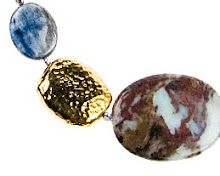
Despite its fairly common availability and affordable market value, agate beads hold a fascinating place in human history. Used for its hardness to make tools by man's forerunners in Ethiopia's Omo valley as far back as 2.5 million years ago, placed in talismans, rings, and amulets by Persian magi for its magical properties over 1500 years ago, and worn by millions of people across the globe for aesthetic and healing value today, agate has always held high esteem in the world of gemstones. The wonderful metaphysical benefits of agate beads have been thought to include everything from improvement of memory, concentration, and analysis, as well as curing of insomnia, poor circulation, and pancreatic dysfunction, to the generation of honesty and goodwill, and perhaps more fantastically, the ability to control weather patterns. A rich mythos has developed around agate beads, indeed!
The agate gemstone forms in cracks, fissures, and cavities in rock formations, typically volcanic in origin. Where various levels of rainwater, silica, manganese, iron, and other mineral oxides combine slowly, layer after layer of the developing agate gemstone form in the 'host' rock's recesses. Because of the variety in minerals that eventually comprise the agate's makeup, the agate gemstone resulting from this extensive and time-consuming process often has a stratified appearance when cut open, much like rings of tree bark or the concentric layers of an onion, but with a great deal more visual complexity. This is explained by layers of clear, glassy quartz that alternate with waxy, translucent chalcedony.
Porous surface layers give the agate bead a very absorbent quality with regards to dyes. This property, on top of agate gemstone's widespread availability in most continents and the presence of modern cutting workshops, has lead to a huge proliferation of agate colours and styles in the world of gemstone jewelry. Furthermore, many still hold value in agate gemstone's deep history and alleged healing capabilities, and the agate stone has witnessed recent rejuvenation in growing 'New Age' industries. Others simply love its timeless look!
The name 'agate' derives from the Achates River in southwest Sicily, where it was initially discovered.
Click here to browse Agate at Stones and Findings

No comments:
Post a Comment